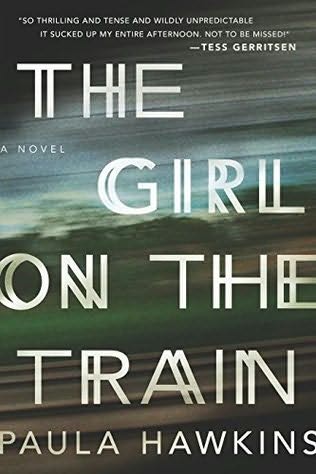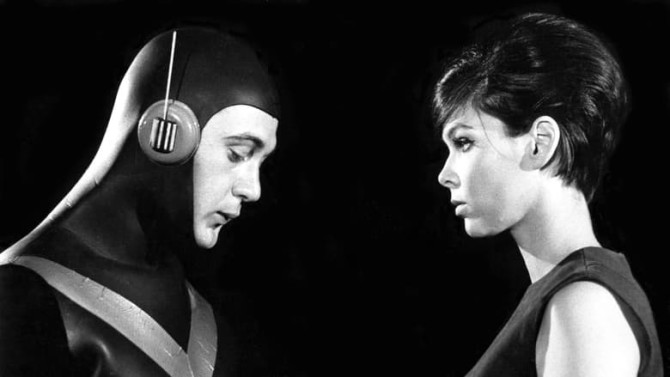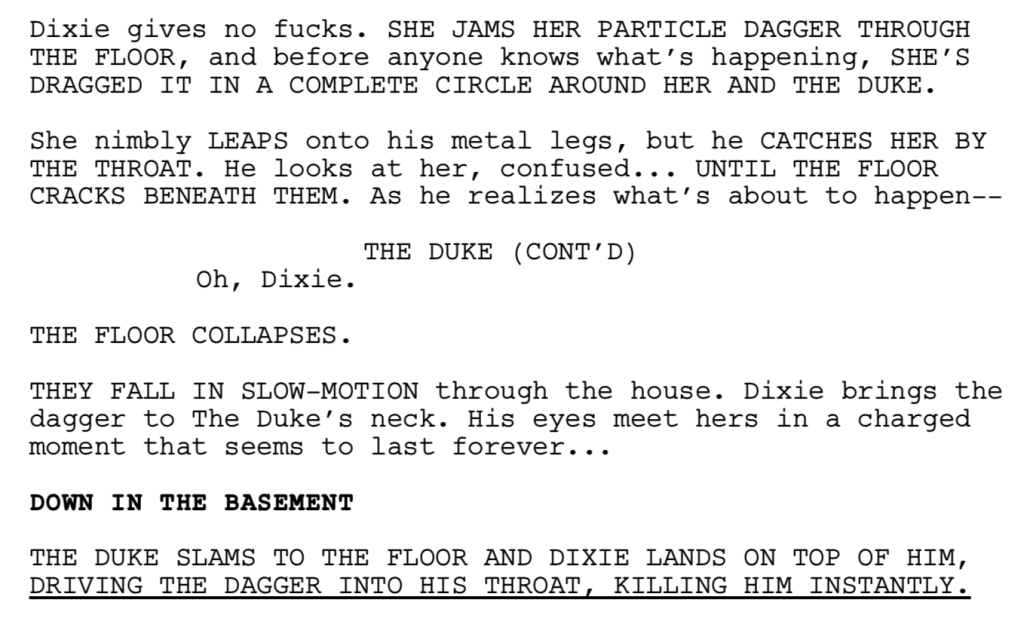Search Results for: girl on the train
Genre: Crime-Thriller
Premise: An alcoholic woman who becomes obsessed with a couple whose home she passes every day on the train, is convinced she knows what happened when the woman in the relationship goes missing.
About: This is Paula Hawkins’ first official novel, but she has written a few chick-lit books under a pseudonym, although you couldn’t’ get her to tell you the titles if you tried. A former financial analyst and journalist, Hawkins explains The Girl On The Train as her last-ditch attempt at becoming a novelist. Hawkins says of how she came up with the idea: “I used to commute when I was a journalist, from the edges of London. I loved looking into people’s houses. The train went really close by apartments, so you could see in. I never saw anything shocking, but I wondered, if you saw anything out of the ordinary, an act of violence, who would you tell and would anyone believe you?” Dreamworks has optioned the book, although the film doesn’t have a star or director attached yet. That could change soon. The book now has 10,000 Amazon reviews (Gone Girl had 20,000 when David Fincher became attached).
Writer: Paula Hawkins
Details: 326 pages
Just Monday we had a guest author chime in on how much freedom one has when writing a novel – being able to play with the narrative, taking different points of view – and boy does today’s novel support that claim.
There will be, of course, people who shrug The Girl On The Train off as a Gone Girl clone, a book that came along at just the moment Gone Girl movie mania was sweeping the nation. The novel, like Gone Girl, is a crime-thriller, takes us through different points of view in regards to a missing woman, and, in case you hadn’t noticed, has the word “Girl” in the title.
But what might surprise you is that “Train” is better than Gone Girl. I don’t say that easily. Gone Girl’s amazing first half and mid-point twist help it win the “first half of the book” award. But whereas Gone Girl starts running out of steam once it leads to its inevitable conclusion, “Train” only gets better as its climax approaches.
That was always my big problem with Gone Girl – the book, and then the movie. As much as Gillian Flynn tried to convince us that her dark weird ending was the way she preferred it, it was clear that she simply wrote herself into a corner – confirmed later in an interview where she confesses to not outlining – one of the most important aspects in writing a great ending. The Girl On The Train has no such issues.
Middle-aged Rachel Watson has pretty much given up on life. She ruined her marriage to the perfect man by drinking too much, then watched as he moved into the arms of a younger prettier woman. Rachel moved out of town, got fat, and now rides the train every day to a job she doesn’t have anymore, but which she must pretend to have in order to keep her flatmate from kicking her out of her apartment. And oh yeah, she’s rarely sober.
The lone light in Rachel’s life is Jason and Jess, a perfect couple who live in a house she passes on the train every day. The two are always outside, kissing, hugging, living that perfect life Rachel once had. Of course, their real names aren’t Jason and Jess. Those are the pretend names Rachel has given them, which seems appropriate, given her happiness exists only in a fantasy world she creates.
Rachel first noticed Jason and Jess because their home is a few houses down from where she used to live. Her ex-husband still lives there, now with his perfect replacement wife, Anne. Rachel would like to say that she’s a big girl who’s moved on from that world. But the truth is, she gets drunk every night and stalks her husband, both on the phone and at the house. We learn very quickly that Rachel isn’t exactly… stable.
Then one day, everything changes. As she’s passing by in the train, she sees “Jess” outside her house with ANOTHER MAN. Her fantasy world destroyed, she’s unable to process this information for days. However, it’s what happens after that really shakes her foundation. “Jess” goes missing, and no one has any information on what happened to her. No one, that is, but Rachel.
Rachel, excited to actually have a purpose in life again, goes to the police to inform them about the man she saw outside with “Jess” (real name: Megan). But they dismiss her as a sad middle-aged drunk woman. It’s for this reason that Rachel must take on the case by herself. Well, at least in her opinion that is.
The book jumps back and forth between the points of view of Anne (Rachel’s replacement), Megan (the missing woman before she goes missing), and of course, Rachel. What makes the investigation so fascinating is that Rachel is wasted half the time, so she’s just about the most unreliable narrator ever.
She wakes up each morning only vaguely remembering the night before, making her investigation a puzzle where all the pieces are upside-down. The whole time we’re excited as we get closer to the answer. But we’re always wondering: Can we really trust anything we know here? Or is Rachel just a sad lonely woman who’s making this all up? Or is the answer much worse? Could Rachel somehow be… involved?
 Michelle Williams, Hawkins’ dream acting choice for Rachel.
Michelle Williams, Hawkins’ dream acting choice for Rachel.
Whether you’re writing a novel or a screenplay, there’s one thing you’ll almost certainly need to succeed – and that’s a compelling main character. I don’t know if characters get more compelling than Rachel Watson. Imagine being inside the mind of a train wreck who does the most horrible things, but can justify each and every one of them, and maybe even convince you they’re not so terrible too.
At one point in the story, Rachel steals a baby. Let me repeat that. THE MAIN CHARACTER STEALS A BABY. And we still root for her!
Sound impossible? Well, there’s a bit of a trick going on here. In a movie, it’s hard to have a character do something like steal a baby and the audience root for them. That’s because we only see their actions. We’re not in their head with them. Girl On The Train has the advantage of placing us inside Rachel’s head. So when she explains WHY she steals the baby, it doesn’t sound all that crazy. I mean, she still shouldn’t have done it. But we can at least understand what she was thinking at the time.
This is why you’ll often hear voice over in movies when bad characters are the protagonists. The writers know you’ll never justify their actions from afar. But if you’re in their head with them, it’s possible to understand where they’re coming from. (House of Cards Season 2 spoilers). For example, in House of Cards, Frank Underwood is always talking directly to us, explaining why he’s doing the horrible things he’s doing. So even though we might not agree with him, we see where he’s coming from. When he throws Zoe Barnes into a train, killing her, a few words explaining how dangerous she was makes the pill a lot easier to swallow. And “Train’s” Rachel Watson benefits from this same “first person perspective” halo.
Another reason we’re lenient towards this character’s terrible tendencies is because she’s ACTIVE. Readers and audiences like characters who DO STUFF. Characters who are passive, who watch the world go by and do nothing, we have no patience for these wallflowers. But no matter how “bad” someone is, if they’re at least trying to do something, we’ll want to see if they succeed. And Rachel, while not exactly Sherlock Holmes, throws herself into this investigation with gusto. She wants to solve the mystery, so of course we want to see if she pulls it off.
In addition to this, Rachel is, at her core, doing a good thing. She’s trying to solve a murder. Sure she’s lying to everybody. Sure she steals babies. Sure she gets blackout drunk every night. Sure she stalks her ex-husband and leaves 20 screaming voicemails on his phone every night. But she’s trying to solve a murder and expose a killer.
As crazy as it sounds, I’ve read versions of this story where there is no killing. There’s just a drunk main character who stumbles around the city feeling sorry for him/herself the whole time. I’m much less inclined to root for that character than I am one who wants to solve a murder, who has an honorable goal to execute.
I don’t want to spoil too much here because the brilliance of this book is in its surprises, but I will leave you with one more thing. MAKE YOUR CHARACTERS LIARS. Everything becomes so much more interesting when people are hiding things. Part of the deliciousness in Girl On The Train is that Rachel lies to everyone. Seeing if she’s going to get caught is part of the fun.
For instance, when she approaches “Jason,” the missing girl’s husband, to let him know that she saw “Jess” with another man, she can’t tell him that she’s watched them every day for the past two years on the train. That would make her sound crazy, right? So she makes up a little lie about knowing “Jess” from her art gallery. Of course, as their relationship grows, Jason requires more information about her friendship with Jess, and Rachel is forced to add more to the lie. At a certain point, she’s locked into a story that’s completely made up. And when that story gets exposed to other people, like the cops, Rachel has to come up with more lies to explain away that lie.
I know a lot of you don’t have time to read books but this one reads like a screenplay. It’s really fast. And I highly recommend it.
[ ] what the hell did I just read?
[ ] wasn’t for me
[ ] worth the read
[x] impressive
[ ] genius
What I learned: Use LIES WITH LEGS over simple lies. A simple lie can result in a fun scene. Frank secretly takes some money from his wife to go gambling, comes home to see his wife home early, she asks him where her money is, and he makes up a lie. The lie doesn’t quite make sense to her, so she questions him about it. The suspense comes from whether he’ll talk his way out of the suspicion or not. But a much more powerful lie is a lie that has legs. It’s a lie that the character HAS TO KEEP BUILDING ON. That’s what’s so great about Girl on The Train. Rachel tells all these little lies. But they’re lies that matter in a detail-oriented missing-woman’s search. So they’re brought up again and again to her (How does she know “Jess” exactly?) and she has to come up with more lies to cover for her previous lies. That’s one of the areas where this book really shined. A lie was never just a simple lie. It was forced to keep growing.
Genre: Action/Crime/Comedy
Premise: An assassin gets stuck on a Japanese bullet train with several other assassins, all of whom get mixed up in an intense plan by an evil mastermind named The White Death who’s determined to kill them all.
About: The David Leitch directed Brad Pitt starrer, Bullet Train (!) racked up 30 million bucks this weekend. It’s not a ton of money and no doubt they were hoping for something closer to 45 million. But maybe Bullet Train never had the firepower capable of significant box office damage. Here’s my old Bullet Train script review.
Writer: Zak Olkewicz (based on the book by Kotaro Isaka)
Details: 126 minutes (screenplay was 121 pages)
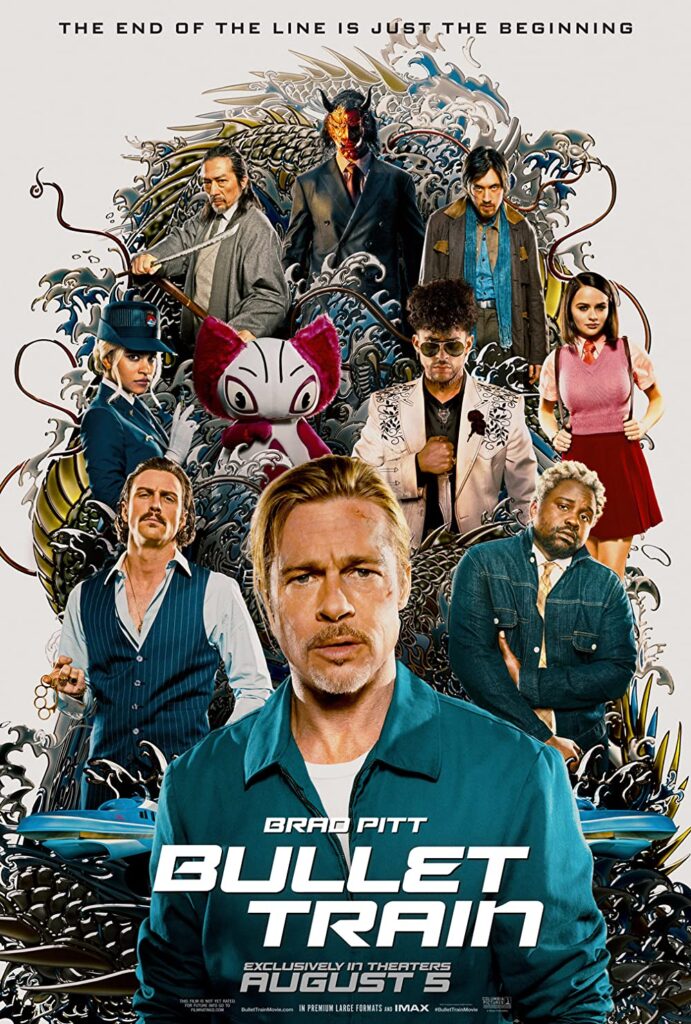 Poster of the year?
Poster of the year?
This is a PANDEMIC SPECIAL.
It was a movie created specifically to be produced during the pandemic. Almost the entire film is shot on a tight movie set (a series of train cars). And you can definitely feel that while you’re watching it. Even when the actors are pretending to be in mortal danger, I don’t think we ever really believe they are.
Bullet Train follows an assassin named Ladybug (Brad Pitt) who’s in Tokyo where his job is to grab a suitcase on a train, then get off at the next stop. Unfortunately, the guys he steals the suitcase from, Tangerine and Lemon, figure out what he’s done before he’s able to get off. So they chase him around the train to steal it back.
Meanwhile, there’s this psycho teenager girl named Prince who’s zig-zagging around the train killing people for her own nefarious purposes. Her ultimate plan is to assassinate the most fearless killer in the world, The White Death, who’s waiting at the end of the line. As we get closer to our destination, these two storylines – Ladybug’s and Prince’s – intersect, resulting in both needing to take on The White Death together.
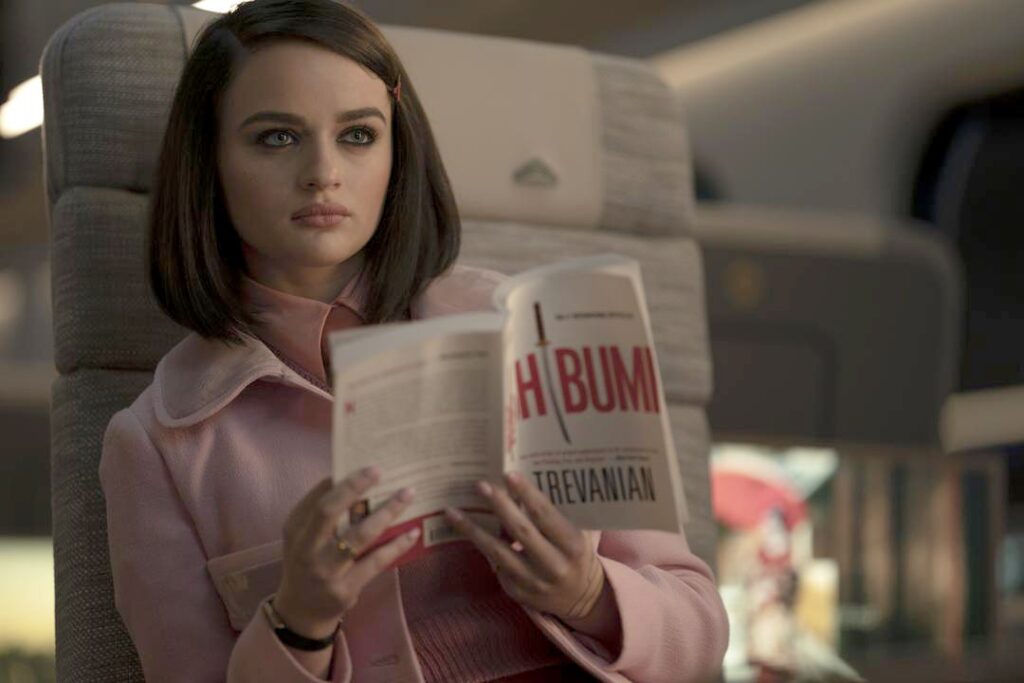
Let me help you see just how incestuous Hollywood is.
Back in 1998, a young British director named Guy Ritchie released a cool little crime-comedy called Lock, Stock and Two Smoking Barrels. The movie was heavy on over-the-top comedic dialogue, quick cuts, and guns.
The film made Ritchie a known name in Hollywood, which attracted many a movie star who wanted to be a part of his first American production. The actor who won that lottery was mega-star Brad Pitt, who played the character of Mickey in Ritche’s “Snatch.”
As Brad Pitt’s career continued, he would need a stunt double for every project. And the man who became his main stunt double at the time was a guy named David Leitch. Leitch, along with fellow stunt man, Chad Stahlenski, muscled their way into the directing chair after a couple of decades, directing the surprise hit action film, John Wick.
Meanwhile, Brad Pitt, in what would become one of his most memorable roles, played a stunt man named Cliff Booth in Quentin Tarantino’s Once Upon a Time in Hollywood. Tarantino, of course, was a gigantic influence on the aforementioned Guy Ritchie.
Cut to last year, when Brad Pitt, he who just played a stunt man for Quentin Tarantino, a major influence on Guy Ritchie, decided to join Bullet Train, a movie directed in the same fashion as a Guy Ritchie film, where he would be directed by David Leitch, a man who, for over a decade, was Brad Pitt’s stunt double.
Crazy, right? What does it all mean?
For starters, it means don’t try to make a Guy Ritchie movie when you’re not Guy Ritchie.
But discussing Bullet Train is actually more complicated than that. This is not a bad movie. It’s not a good movie. It’s a movie that exists. And if you’re like me and into the little details about why a movie works or doesn’t work, this is a fun one to dissect. Because there isn’t any one thing that hurt this movie. Rather, it was a bunch of little bad decisions.
Before we get into the screenwriting stuff, I have to say that choosing to make a comedy when your lead actor is not a comedian, when your supporting cast are not comedians, when your director is not a comedic director, and when your writer is not a comedic writer, probably isn’t the best idea.
Comedy is very hard to pull off. If the timing is off by even half a second, it could be the difference between a big laugh or no laugh. And that was Bullet Train in a bullet shell. The timing on the jokes always felt off. We’re not talking Ben Falcone bad. But the movie felt like an approximation of how an action-crime-comedy should play. It never reached that assuredness that a Guy Ritchie would bring to the party.
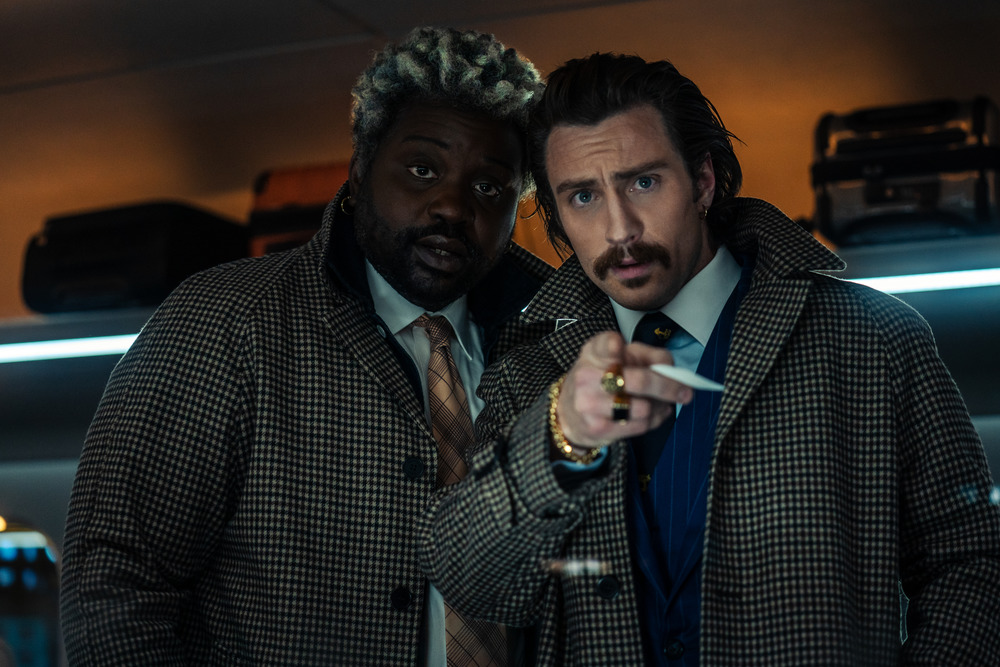
But we’re not here for the filmmaking. You can get opinions on that anywhere. We’re here for the screenwriting, baby. And the screenwriting in Bullet Train is a primary example of why flashbacks can be so dangerous.
Flashback is made up of two words.
FLASH and BACK.
“Back,” in particular, is a scary word in screenwriting parlance because stories work best when they’re going FORWARD. Not BACKWARDS.
So if you’re doing something with the word “back” in it, you’re literally going against what makes movies good.
Bullet Train is obsessed with stopping the story and doing occasional little flashbacks where we learn more about the characters’ backstories. In theory, this isn’t the worst idea. The more we know about someone, the more we’ll care about them (theoretically). So I understand the reason for the choice.
But every creative choice has a drawback to it – some bigger than others – and when you’re choosing to flash BACK, the big drawback is that YOU STOP ALL FORWARD MOMENTUM OF YOUR STORY. Believe me, the audience (and the reader) feel this.
My interpretation of how Leitch approached this device was to keep the flashbacks so fast and fun, it wouldn’t feel like the story was stopping. The problem was there were a lot of flashbacks. And, more importantly, they weren’t as cool or as funny as they were trying to be. So because they weren’t working, we felt that narrative stoppage every time a flashback arrived, and because that kept happening, the movie was never able to keep our attention. We were always drifting out then being pulled back in.
Also, when so much of your movie depends on cutesy fun dialogue, you better be lights out at writing cutesy fun dialogue. You can’t be okay at it. Or even slightly better than average, which is where I’d rank the cutesy fun dialogue in Bullet Train. If something is being done so frequently in your screenplay that it’s part of the fabric of the movie, those are the areas you have to nail. And they weren’t nailing them.
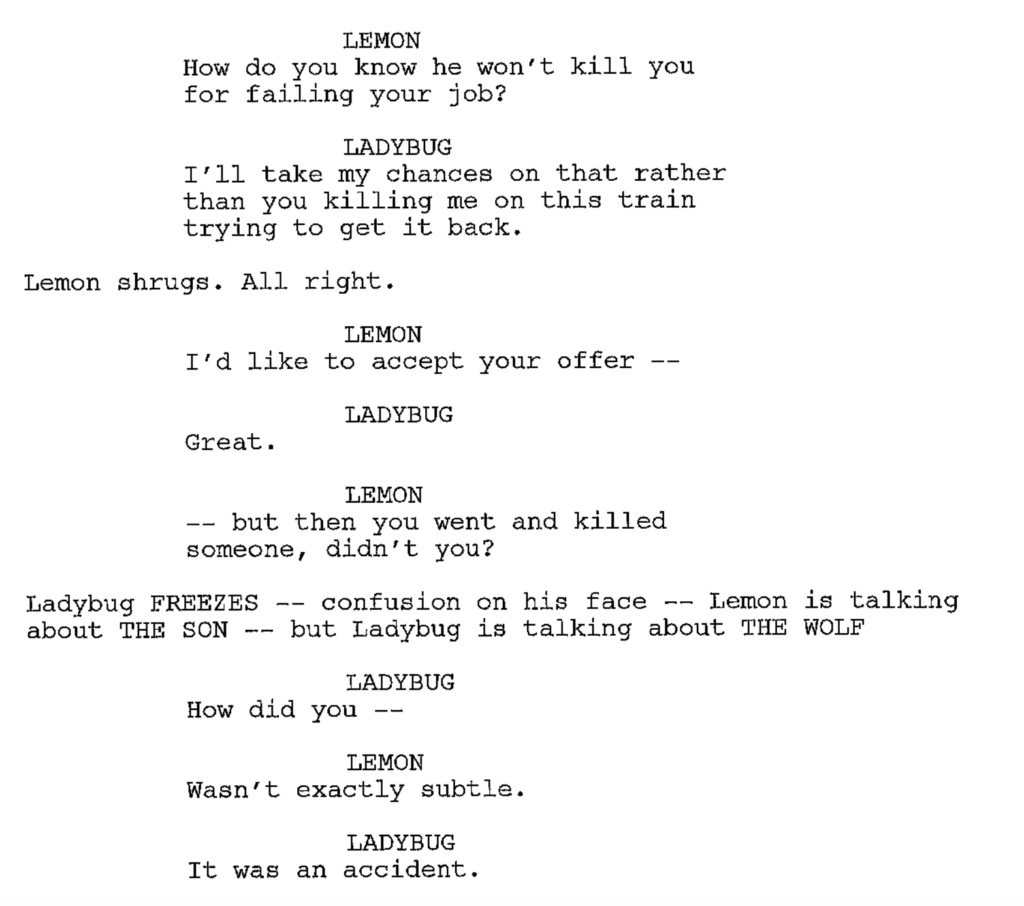
Another major error that they made on the screenwriting front was the main character, Ladybug (Brad Pitt).
They never explained him well. Is he a trained killer? Because he seems to be able to kill a lot of skilled assassins. But he acts so goofy all the time that I think we’re supposed to believe he lucks into all of these kills. That they had nothing to do with skill. Which means he’s basically Jar-Jar Binks.
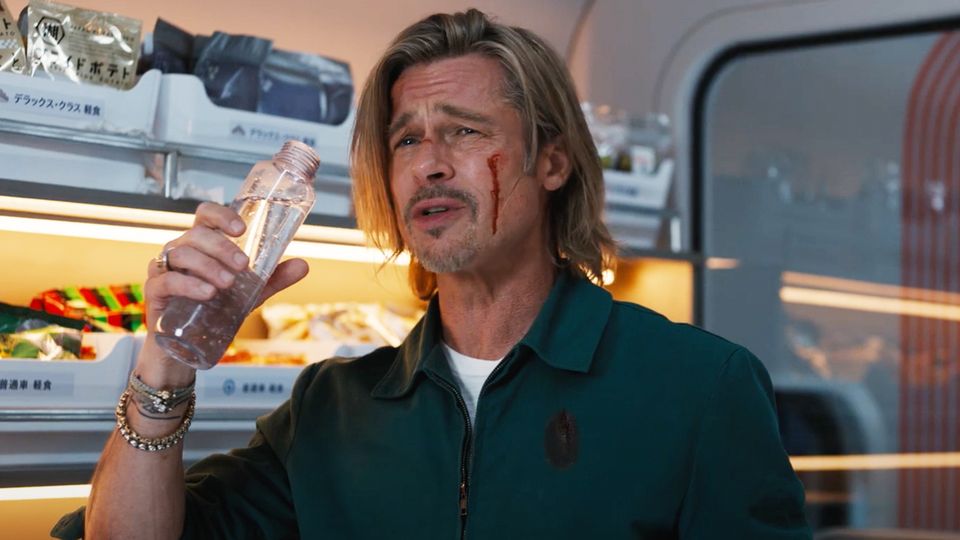
But I was never entirely clear on that. Is he good fighter? Is he a bad fighter who gets lucky? Or maybe he’s a good fighter who no longer wants to fight so he plays defense the whole time? It was confusing, man.
I will say that I liked the decision to use Maria, Ladybug’s handler, as a constant source of voice over. One of the harder things to do in a script like this (with five different assassins all chasing individual plotlines) is keep the audience up-to-date on what’s happening. By creating this handler who calls Ladybug intermittently, she can keep reminding Ladybug (and by association, us) what’s going on and what he needs to do. She can remind him, for example, that he has to get out at this next stop. And it goes both ways. Ladybug can remember out loud to Maria other relevant exposition. “Oh yeah, I remember that guy. He was at the wedding I was at where I killed the bride.”
If Maria is not in this movie, how do we get this information? Ladybug would have to talk to one of the enemy characters about it. Which wouldn’t be believable at all. It can be done, of course. But as a screenwriter, you should always be looking for strategies to attack exposition in a movie that has a lot of moving parts (and therefore will require a lot of exposition). They had a good strategy here.
I also liked the ending more than I thought I would. The movie does such a good job setting up the character of The White Death that we want to see what happens when he shows up.
And remember, whenever you’re writing a movie and you’re unsure about your climax, just go back to your concept. The answer is always in your concept. This movie is called Bullet Train. Therefore, the movie needs to have a big splashy bullet train crash. And they don’t disappoint. If you’ve ever asked the question, what happens to a bullet train when it runs out of track, this movie gives you the answer. I point this out because there was a moment where it looked like they were going to end the movie at the Kyoto stop with a big flashy fight just outside the train. That ending would have been disastrous.
If I had just one word to describe Bullet Train, it would be, “frustrating.” There was definitely a good movie in here, but the decision to turn it into a comedy when nobody involved is known for comedy was kinda fatal. If this were a streaming movie, I’d tell you to watch it for sure. But I can’t, in good conscience, say it’s worth paying for in theaters.
[ ] What the hell did I just watch?
[x] wasn’t for me
[ ] worth the price of admission
[ ] impressive
[ ] genius
What I learned: Physical movement is powerful in visual storytelling mediums. If we’re physically moving towards something, it creates the illusion of importance later on since the audience naturally want to see where the movement stops. That’s what kept Bullet Train just watchable enough, was the need to see where the train stopped. But you can do this with characters moving (1917) you can do it with a vehicle (Mad Max). You can do it in a spaceship (Passengers). Movement is typically preferable to stillness in movies. Which should be evident from the word itself – “Movie.” Aka, “Moving.”
Genre: Action
Premise: An assortment of assassins and criminals are all stuck on the same Japanese bullet train searching for a briefcase with 10 million dollars in it.
About: It’s the hottest project in Hollywood. John Wick’s David Leitch is directing this monster movie for Sony which will star Brad Pitt, Lady Gaga, Sandra Bullock, Aaron Taylor-Johnson, Zazie Beetz, Logan Lerman, Joey King, Michael Shannon, and most importantly of all, the return of Masi Oka, who played “Hiro” on the show “Heroes.” Bullet Train is based on a novel by Kotaro Isaka and was adapted, somewhat surprisingly, by Zak Olkewicz, who doesn’t yet have a produced writing credit (although he has a lot of scripts in development and has been featured on the Black List).
Writer: Zak Olkewicz
Details: 121 pages (2/21/20 draft)
This project has been all over the news for months – a non-stop feed of high-profile casting announcements. Which made me curious as that usually means the script has a lot of great characters in it. Also, I like thrillers on trains. There’s something about being cooped up on a train with nowhere to go that intensifies a situation. It’s the same reason I like plane thrillers (by the way, I’m going to review that monster plane thriller that 12 studios bid on in the next two weeks).
So does the script live up to the hype? Get your metro passes ready, baby, and we’ll find out together.
Kimura is a Japanese man with a major drinking problem. In fact, he was passed out when his young son climbed up on a roof and fell off, sending him to the hospital, clinging to life. That’s the reality Kimura has to deal with now as he gets onto this morning’s Tokyo bullet train.
Meanwhile, we meet Tangerine and Lemon, two hitmen who may or may not be brothers (they claim they’re not). Tangerine is the brains of the operation, while Lemon can’t stop talking about Thomas the Tank Engine, that kid’s show about a train with a face. It is through the prism of Thomas that Tangerine understands the complex workings of the world around him.
Tangerine and Lemon, who love bantering by the way, are in possession of The Son, who is the son of a Russian crime boss and all around terror best known as The Black Death. Some men kidnapped The Son and Tangerine and Lemon showed up with their ten million dollar ransom, but instead of giving it to the kidnappers, they killed them, all 17 of them in fact (we get a quick flash-cut of all 17 kills). Now all they have to do is deliver the suitcase of 10 million dollars and the Son to the Black Death at the end of the line.
There’s a small problem, though. Lemon thought it would be a good idea to leave the suitcase in the storage area, which has allowed a private investigator named Ladybug (a man, in case you were wondering) to take the suitcase and scuttle off to some other part of the train. When Tangerine and Lemon realize what’s happened, they make it their primary focus to find the person who stole their suitcase. The reason this is their primary focus is because if this person gets off at any stop and disappears, the two of them will be dead.
Back to Kimura, who is moseying about the train when a teenage girl named Prince (yes, I know Prince implies she’s a boy) snags him and ties him up in one of the compartments. She explains to Kimura that he is going to help her kill The Black Death. And if he doesn’t, she has a nurse on call in the hospital where his son is at and that nurse is going to kill him.
If all of this isn’t crazy enough, a giant poisonous snake is slithering its way around the insides of the train because… well, because why not? I suppose you could say it’s a precursor to just how crazy things are about to get. Because once Tangerine and Lemon get back to their seat after their first run-though on the train, they find that The Son is DEAD. Uh oh. Now what are they going to do?
Before long, we realize that the person we really have to be worried about is Prince. Prince is a legitimate psycho. She not only kills Kimura, but as he lays dying, she explains, in detail, how she’s going to slowly kill his son. Sounds like she’d be great at parties. All of this is happening amidst the broader question of, who is The Black Death? And what is he going to do when he learns that neither his alive son or his 10 million dollars is waiting for him at the last stop?
Let me start off by saying this is the kind of movie I would like to produce. All it cares about is that its audience has a good time. Every character, every dialogue scene, every plot choice, is designed to entertain. However, that doesn’t guarantee it *will* entertain. Intentions are not results. You still have to deliver. So let’s look at this piece by piece to see if it delivered.
For starters, they use a good old fashioned McGuffin. Which is the briefcase. This is the *thing* that all the characters are after. I don’t think a lot of writers understand why a McGuffin is so useful. The main reason is that it makes every character in your story active. If everyone’s got the same goal – get the suitcase – then they will all be actively pursuing something.
The best thing about a well-constructed McGuffin is that it creates collisions. Characters will keep bumping into each other. And since the characters want the same thing and only one of them can have it, there is natural conflict in every interaction. That’s an underrated story device, in my opinion – the value of constant collision between characters. The more of that you have going on, the more drama you’re going to have in your screenplay.
But even if you do these things, it does not guarantee a successful result. That’s because the individual pieces themselves – the characters – must all be interesting. And I think that’s where you’re going to have differing opinions on Bullet Train. They’re going for this late 90s, almost Tarantino-like approach, to the characters – especially Tangerine and Lemon – and it’s hard, when reading their dialogue, not to think about how much better Tarantino is at this stuff. That’s not to say the dialogue is bad. But it has a little bit of a try-hard quality to it. The Thomas the Train stuff, in particular, was overcooked. It’s one thing to bring it up a couple of times. But it’s literally all Tangerine talks about.
Luckily, those two are balanced out by Prince, who’s an excellent character. In fact, I think Joey King is going to steal this movie. She’s a legit psychopath, essentially playing the worst version of a Generation Z teenager. If you’ve ever thought you’ve run into the most entitled person you’ve ever met, wait until you meet Prince.
Another thing I liked about Bullet Train is that it made some splashy unexpected choices, which I think you have to in a movie like this. If you play a movie called Bullet Train, where a bunch of assassins are stuck in a train together, too straight? You’re missing out on some fun. So I liked the fact that there’s this random snake on the loose. I liked that The Son dies on page 30. I like anything that makes the audience think, “Uhhhhh, now what?”
I do have some advice for those writing scripts like this. You have to rewrite these scripts incessantly. Because they are highly dependent on how clever they are. And the best way to be clever is through setups and payoffs. But, as seasoned writers know, setups and payoffs are always clunky in the first few drafts. You have to keep smoothing them out over time to the point where you don’t even notice the setup.
And I don’t think Bullet Train quite got there. Then again, this is a 2/21/20 draft. I don’t think they started shooting until this year? So they’ve had some time to clean those up. What they’ve got here is good. But when you’re jumping around this much and there’s so much to keep track of, you have to rewrite tirelessly to get all the setups and payoffs exactly right.
Final thoughts. This was good. It’s going to be a fun movie. In fact, I’d say it’s the exact type of movie we need right now. Good old fashioned movie magic fun.
[ ] What the hell did I just read?
[ ] wasn’t for me
[x] worth the read
[ ] impressive
[ ] genius
What I learned: Design a script with a bunch of fun characters who get to do a lot of fun things. You do that and you get actors wanting to play parts. This isn’t as important in studio movies where money gets you any actors you want. But when you’re an aspiring writer trying to make a name for yourself, a script with a bunch of actor-friendly parts is a great way to get noticed, and, more importantly, get your movie made.
Genre: Drama/Comedy
Premise: Two weed growers who have been dating for over a decade have their relationship upended when one of them wins a reality TV show contest to fly to Mars.
About: This script finished on last year’s Black List with six votes. It’s an adaptation of a short story from Deborah Willis in her book, “The Dark and Other Love Stories.”
Writer: Kaitlin Fontana (from a story by Deborah Willis)
Details: 115 pages
Someone told me not long ago that Mars movies were dead.
To them I say, WRONG-O!
And CHECK URSELF B4 U WRK URSELF!
One of the first lessons I learned about Hollywood is that something is only dead until it isn’t. A year after I was told that Hollywood would never make a pirate movie again, Pirates of the Caribbean came out. So I learned to distrust Hollywood rhetoric early on.
As long as you have a good idea, you can make any “dead” genre work. But that’s the key. It has to be a good idea.
Today’s idea is… funky. Different. I like the title! That’s what made me open the script. But does the script live up to that title? Let’s find out.
Kevin and Amber have been dating for twelve years. Both of them lack purpose. They start growing weed in their basement so that they never have to do anything with their life. But then Amber goes off and applies for a reality show that ends with two people going to Mars.
Kevin watches helplessly as the newly purposeful Amber flies to the reality show location to start her training. While this is happening, we jump back to earlier points in Kevin and Amber’s relationship to show how they met. I would say “how they met and fell in love” but this relationship is more a relationship of convenience.
The script also turns Kevin into a somber version of Ferris Bueller who will talk straight to us, the viewer, about why this situation sucks so badly. Well, Kevin, it’s about to get worse. Every Thursday Kevin watches his girlfriend on the reality show as she becomes closer and closer to another contestant, the handsome and cool, Adam.
Eventually, Amber and Adam are sent up on a space capsule for six months to simulate the trip to Mars. See if they can handle each other for that long. The answer comes to us in a stunning visual. When the two exit the capsule, Amber’s pregnant!
But don’t worry. Kevin starts screwing around with some druggie chick named Tanya who not only comes around to smoke weed all the time, but happily watches the reality show with Kevin’s girlfriend in it. Alas, Kevin gets bored of Tanya and dumps her. Will Kevin ever find happiness? And will Amber and Adam be heading to the real Mars? Check out Girlfriend on Mars to find out!
I’m going to isolate this script’s problems down to a single issue.
A depressed inactive aimless main character is too much for a script to overcome. It’s hard enough to get an audience to root for a depressing character. But then when you add in that he doesn’t do anything but sit on the couch all day and watch his ex-girlfriend’s reality TV show, that’s something no screenplay can make work.
On top of that, you have two storylines. One where a girl is training to go to Mars and the other where a guy sits on the couch all day. Which one of those storylines sounds more interesting? I’m hoping you said the first one. But we don’t spend any time with Amber. We instead stay back at the house, on the couch, with Kevin.
You have to look at this logically.
You’re trying to make a movie.
So you have to imagine what your movie is going to look like onscreen. If 80% of your movie is a guy on a couch, how is that going to look onscreen? I’d imagine it would look pretty un-cinematic.
So either focus on the part of your movie that IS cinematic or repurpose the story you want to tell (in this case, Kevin’s) so that it’s MORE cinematic. And that goes right back to our main character. The simple adjustment of making Kevin more active means he’s going to be out there in more situations encountering obstacles and trying to overcome them, which is cinematic.
Now you may say, well Carson, the whole point of his character is that he’s the opposite of his girlfriend. He’s depressed. He has no motivation. That’s his character’s flaw! And what I would say to you then is, okay, so is it a good idea to write a movie about that character?
This is why I always say, one of the best things you can do when you’re putting your story together is to figure out how your character is going to be active.
The only time I’ve found that lazy inactive characters work is when they’re FORCED to be active and when it’s a comedy. Two classic stoner comedies, The Big Lebowski, and Pineapple Express, take stoner passive characters then thrust them into their worst nightmare. THEY MUST BE ACTIVE. That’s why those movies are so fun. Lebowski would not be a classic character and Pineapple Express would not be a beloved comedy if those characters were able to chill out doing nothing but smoking pot the whole movie.
This leads to a bigger question, which is, is there a movie here?
I think there is if you go the full comedy route. And you’d need to figure out a way to keep Kevin and Amber around each other. He would need to go to wherever she was training so they’d still be spending time together.
Because by making her so far away, you dilute the importance of their relationship. You want characters who are having problems with each other to be around each other. That’s when they’re the most interesting to watch. Cause we want to see if they’re going to resolve those issues or not.
It’s hard to feel any emotion with the two on the phone or Kevin watching her on TV. It all feels so far away and unimportant.
But, yeah, this needs to be a full-blown comedy. I mean, the title is, “Girlfriend on Mars.” That’s a title that elicits a laugh. You need a funny script to accompany it.
In the writer’s defense, this is a first draft of a book adaptation and those first drafts tend to follow the book narrative too closely. Books and movies are soooooo different. The storyline of a movie needs to be tighter, it needs a focused hook, and it needs to be simpler. This isn’t the kind of movie you want to burden with a bunch of jumping around in time. It just isn’t that kind of story.
I hope they figure it out.
[ ] What the hell did I just read?
[x] wasn’t for me
[ ] worth the read
[ ] impressive
[ ] genius
What I learned: Novels tend to be more introspective. Movies are more in your face. That’s why adapting a novel or a short story can be tough. But that’s the skill you need to bring to the table as a writer. You must figure out a way to take something that’s largely in a character’s head and make it active and cinematic. Sometimes that means drastically changing the story. But you gotta do what you gotta do! Don’t be a slave to the original material if it’s going to make a lousy movie.
What I learned: If there’s a problem facing your hero, you should write the movie so that they have the opportunity to tackle that problem. One of the reasons Girlfriend on Mars is so frustrating is because Kevin has this huge problem – his girlfriend is training to go to Mars and she’s falling in love with her co-pilot – and all he can do is watch. If there isn’t even an option for your hero to solve the problem, there’s going to be very little drama in your movie. This is why I said it would’ve been a good idea to get Kevin and Amber around each other. Now he has a shot at disrupting this.
Genre: Action Thriller Sci-Fi Romantic Comedy
Premise: Barret is a social media influencer, the worst guy ever, and the eventual President of the United States. Dixie is a badass freedom fighter, sent back from 2076 to kill him before he takes over the world and ruins the future. They fucking hate each other. Then they accidentally fall in love.
About: This script finished Top 10 in last year’s Black List, a surprising showing considering the main character isn’t a real person (biopic joke). Michael Daldron seems to thrive in the absurd. He was a writer on the bonkers Dan Harmon TV show, Rick and Morty.
Writer: Michael Waldron
Details: 104 pages
We’re going to keep the absurdity alive this week! Yesterday, we covered a character who fell in love with a toe. Today, we explore traveling back in time to wipe out social media influencers.
What’s a social media influencer? I only found out the other day after watching Netflix’s Fyre Festival doc, a task I initially resisted because the media’s become a scourge of evil intent on destroying people’s lives regardless of whether they deserve it or not. I figured they did the same thing to this Fyre Festival dude. But ohhhh no. This guy deserved to be taken down. The crap he pulled would’ve caused a coma patient to stand up and demand action. I loved it so much I re-activated my dead Hulu account so I could watch their competing Fyre Festival documentary, which turned out to be even better than Netflix’s.
Anyway, all this is to say that social media influencers (the people who made Fyre Festival a “thing”) are vapid black holes of emptiness, the bottom rung of entertainment. And the current generation is growing up on them, which means they’re going to be the primary source of entertainment at some point. Get your Logan Paul merch while you can still afford it!
20-something Dixie lives in the year 2076, a post-apocalyptic future that is the result of a stupid douchebag of a social media influencer, The Duke, becoming president and ruining everything. After searching far and wide, Dixie locates a time-traveling backpack, and after killing the future version of Duke, goes back to the year 2018 to kill the young version of Duke so that he can never become president in the first place.
Dixie arrives in 2018 and immediately attacks the young Duke (who’s simply named “Barret” here). But within seconds of the attack, a 16 year old Duke disciple, Miller, also from the future, appears in a jet pack and attacks Dixie. Dixie and Miller battle while the confused Barret watches on, tweeting and instagram storying his fans about the attack.
Barret hops in a car and drives off, but Dixie easily catches up to him. When she finally has a clear shot to take him out, she waivers. This Barret may be a nimrod, but he’s far from the megalomaniacal super-douche that runs the country in 2076. After he pleads for his life, Dixie compromises and gives him a last dinner, which they share at Chuck E. Cheese. Unfortunately, the more Dixie talks to Barret, the more she kinda likes him. And by the end of the meal, she decides to postpone the assassination for a little longer.
The next day, Dixie comes up with another plan. If Barret walks back his earlier posts about running for president, he’ll never become president, and the future will be saved without Dixie having to kill him. But this comes with a new problem. If he does this, Dixie will disappear, since the future will completely change and she’ll have never been born. Since the two are starting to like each other, they postpone this ‘not running for president’ post a little longer.
The next thing you know, the two are living together, Dixie is pregnant, and Barret spends his downtime traveling back in time to World War 2 trolling Nazis. When Barret learns that Dixie already killed the future him before she jumped back in time, the two get in a fight and Dixie takes her time-travel backpack, jumps back 65 million years, and starts training velociraptors to talk. I could go on but does it really matter at this point? More time travel. More fighting. The two live happily ever after. The End.
I used to get mad at these scripts – when the comedy is so absurd it takes precedence over plot and character. But now I realize different people think different stuff is funny and while I may not have liked it, younger audiences who don’t put a premium on logic and plot progression will probably enjoy it for the same reasons I didn’t.
I do think a world where Logan Paul is president is a funny setup. My issue is that these types of setups are great for a 22 minute episode of Rick and Morty, but become tiring stretched out to two hours. And you can see that play out as you’re reading the script. Once Dixie and Barret enter into a relationship (about 50 pages in), it’s clear the writer doesn’t know where to go. So he goes everywhere. I mean at one point we’re 65 million years in the past listening to a deep conversation between Dixie and velociraptor.
At times, Waldron’s script almost becomes the thing he’s making fun of. Here we are blasting narcissistic millennials obsessed with Instagram stories yet half the script is written in CAPS while being self-referential and breaking the fourth wall (for example, when a fight occurs, we’re told that it will get nominated for an MTV Movie Award for Best Fight). If that isn’t the screenplay equivalent of a douchey influencer posting an Instagram story, I don’t know what is.
I also think there’s a bigger discussion here about writing a script that’s trying to be fun and writing a script that IS fun. When you’re having fun, it comes off on the page. But when you’re TRYING to write that viral fourth-wall breaking screenplay, it can come off as try-hard and your script quickly goes from cool to lame. Deadpool constantly walks this line and one can make the argument the sequel crossed it. You could feel it desperately trying to make you laugh, instead of trusting its story so that the laughs came naturally.
The one thing I’ll give this script is that, just like yesterday’s screenplay, I didn’t know where it was going. I was dreading a 105 page wall-to-wall comedy action flick where Dixie tried to kill Barret the whole time. That’s what most writers would’ve done. One of the most boring things you can do is to hit the same beat over and over again in a screenplay. You have to come up with clever ways to spin the story in different directions so the plot stays fresh. And Waldron achieved that. I was surprised when these two got together. And I didn’t know where their relationship was going to go from there. I think it says a lot about how much readers value unexpected plotlines that both this and The Toe finished highly on the two big End of the Year lists.
In the end, however, this isn’t my thing. I can throw all the screenwriting gobbledygook at you I want to explain why I didn’t like it. The truth is that when we don’t like something, we can come up with a million reasons why. This script was too juvenile for me. But it’s probably just the right flavor of juvenile for someone else.
[ ] What the hell did I just read?
[x] wasn’t for me
[ ] worth the read
[ ] impressive
[ ] genius
What I learned: Remember that the more words and sentences you cap in a screenplay, the less impact those words have. They become just as normal as uncapped words. Understanding, then, that the point of capping something is to bring to attention to it, use it sparingly, so that you can actually draw attention to the action you want to draw attention to.

